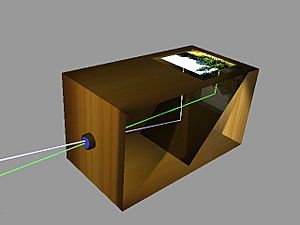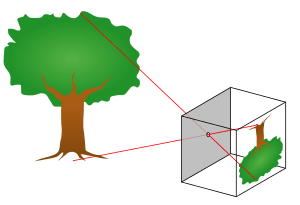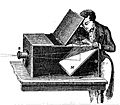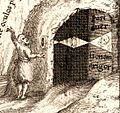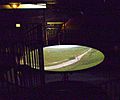Camera obscura facts for kids
A camera obscura is a cool device that means "dark chamber" in Latin. It's like a super old camera! This simple invention helped people discover how to take pictures, leading to the cameras we use today. The word "camera" we use now is just a shorter version of "camera obscura."
Imagine a dark room or box with a tiny hole on one side. Light from outside shines through this small hole. It then projects an image of the outside world onto the opposite wall inside the dark room. This image is usually upside-down! Artists sometimes used this to trace pictures. If the hole is very small, the picture looks sharper. But it also becomes dimmer, so it's harder to see. Sometimes, people used mirrors to make the image appear right-side up.
Contents
Who Discovered the Camera Obscura?
The idea behind the camera obscura, especially the pinhole camera, goes way back!
Early Ideas in China and Greece
The first person to write about the basic idea was Mozi, a Chinese philosopher. He lived a very long time ago, from 470 BC to 390 BC. He was the founder of a group called Mohism.
Later, a famous Greek thinker named Aristotle (384 to 322 BC) also understood how a pinhole camera works. He saw the shape of a partly eclipsed sun. It was projected onto the ground through small holes in a sieve. He also saw it through the gaps between leaves on a tree.
The First Camera Obscura Building
The first actual camera obscura was built by an Iraqi scientist. His name was Abu Ali Al-Hasan Ibn al-Haytham. He was born in Basra (965-1039 AD). In the West, he was known as Alhazen. He did many experiments with light in his book, Book of Optics.
In his experiments, Ibn al-Haytham used the term "al-Bayt al-Muẓlim." This means "dark room" in Arabic. He showed that light travels in straight lines. He also observed the half-moon shape of the sun's image during eclipses. He saw this image on a wall opposite a small hole in his window shutters.
He wrote about this in his essay "On the form of the Eclipse." He said that the sun's image, when it passes through a narrow, round hole, looks like a moon-sickle. He explained that light rays cross over when they go through the hole. This makes the image appear upside down on the wall. He also found that a smaller hole makes a clearer picture.
Even though Ibn al-Haytham is famous for his work, he said he didn't invent the camera obscura. Aristotle was the first to describe how an image forms in the eye, using the camera obscura as an example.
Fun Camera Obscura Places to Visit
Some camera obscuras are built as cool places for tourists to visit! They are often big rooms inside tall buildings. The room can be made dark. Then, a "live" view of the outside world is projected onto a flat surface. This happens through a special rotating lens.
Not many of these old camera obscuras are left today. But you can still find some in these places:
- Edinburgh in Scotland - See the Camera Obscura site
- Johannesburg in South Africa
- Pretoria in South Africa
- Cape Town in South Africa
- Lisbon and Tavira in Portugal
- Santa Monica in California
- Los Angeles at the Griffith Observatory
- San Francisco at the Cliff House
- North Carolina's "Cloud Chamber for the Trees and Sky"
- Havana in Cuba
- Royal Observatory, Greenwich, London
- Marburg, Germany
- Kentwell Hall, Suffolk
There's also a portable camera obscura. It travels around England and the world with Willett & Patteson.
Related Pages
Images for kids
-
An image of the New Royal Palace at Prague Castle projected onto an attic wall by a hole in the tile roofing
-
The gnomon projection on the floor of Florence Cathedral during the solstice on 21 June 2012
-
Holes in the leaf canopy project images of a solar eclipse on the ground.
-
Da Vinci: Let a b c d e be the object illuminated by the sun and o r the front of the dark chamber in which is the said hole at n m. Let s t be the sheet of paper intercepting the rays of the images of these objects upside down, because the rays being straight, a on the right hand becomes k on the left, and e on the left becomes f on the right
-
The first use of the term "camera obscura" was by Johannes Kepler, in his first treatise about optics, Ad Vitellionem paralipomena quibus astronomiae pars optica traditur (1604)
-
Camera obscura in Encyclopédie, ou dictionnaire raisonné des sciences, des arts et des métiers. 18th century
-
Cameras obscura for Daguerreotype called "Grand Photographe" produced by Charles Chevalier (Musée des Arts et Métiers).
-
A freestanding room-sized camera obscura at the University of North Carolina at Chapel Hill. A pinhole can be seen to the left of the door.
-
A freestanding room-sized camera obscura in the shape of a camera. Cliff House, San Francisco
-
Image of the South Downs of Sussex in the camera obscura of Foredown Tower, Portslade, England
-
A camera obscura created by Mark Ellis in the style of an Adirondack mountain cabin, Lake Flower, Saranac Lake, New York
See also
 In Spanish: Cámara oscura para niños
In Spanish: Cámara oscura para niños


